San Juan Travel Guide
The capital city of Puerto Rico, San Juan is one of the busiest ports in the Caribbean and home to a third of all Puerto Ricans. Nearly every visitor to the island arrives at San Juan, many on cruise liners. It's one of the largest home-based cruise ports in the world, hosting many vessels with more being added each year.
San Juan is divided into three distinct districts: Old San Juan, the historic walled city; the beach and resort area; and the outlying suburbs. Tourists mainly visit Old San Juan, the site of most restaurants, shops, entertainment venues and some exquisite beaches.
The old city is linked to the new by the largely residential barrio of Puerta de Tierra and a series of modern highways leading to the Condado beachfront, which is reminiscent of Florida's Miami Beach with its high-rise hotels and apartment blocks.
It is not only tourism that keeps the financial mills grinding in San Juan. The city is an important centre for petroleum and sugar refining, brewing and distilling, and the manufacturing of cement, pharmaceuticals, metal products and tobacco products.
In the midst of all the hustle and bustle, there are numerous attractions in San Juan to amuse, entertain and interest many tourists, and the city is a perfect base for exploring the rest of what this small Caribbean island has to offer.
Things to do in San Juan
San Juan is the busiest cruise port in the Caribbean and a major tourist destination for North American travellers. It is a city with much to offer its visitors: the beauty and history of the old town, artistic treasures of the Museo de Arte and sun-soaked beaches only minutes from the city centre.
The best way to see the sights and experience the city's attractions is to take a walking tour; either using a guidebook or professional guide. The city is compact and flat, meaning it's ideal to explore on foot. Travellers can take regular rests at the charming piazzas while exploring the old town. Also, the area can get busy and crowded as the day wears on.
High tourist season is from December to April, while June to November is far quieter. A note of caution though is that the island can experience hurricanes during this period.
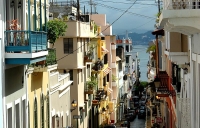
Old San Juan
Encompassing about seven blocks, this area dates back about 500 years to the Spanish occupation when it served as a military stronghold that even withstood Sir Francis Drake's armies. The original cobbles on the streets are blue-tinged and were originally used as ballast on Spanish ships. More than 400 restored 16th- and 17th-century Spanish colonial buildings fill Old San Juan, drawing thousands of tourists who walk the narrow, steep streets every day. The old town is enclosed by thick, high walls and features numerous attractive plazas bearing sculptures and memorials.
Fort San Felipe del Morro
Built in 1540, the mighty six-level fortress of San Felipe del Morro towers 140 feet (43m) above the sea on San Juan Bay, its 18-foot thick (5m) walls having proved a worthy defence against many an invasion. One of the largest fortifications in the Caribbean, it is a maze of tunnels, dungeons, barracks, lookouts and ramps, offering spectacular views from atop its ramparts. In Old San Juan, stands El Morro's partner in defending the city, Castillo San Cristobal, built in the 17th century to a confusing and intricate modular design.
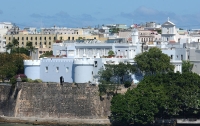
La Fortaleza
La Fortaleza was built in 1540 as a fortress to guard the entrance to the San Juan harbour, but later became the official residence of the governor. During the following centuries, the original structure has been remodelled and expanded, with a neoclassical façade being added in 1846 to lend a certain palatial trait to the place. It is listed as a UNESCO World Heritage Site and is the oldest administrative mansion still in use in the New World.
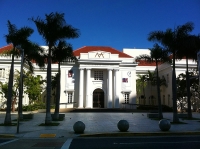
Museo de Arte
Puerto Rico's showcase art gallery is housed in a former city hospital in Santurce and offers a permanent and visiting exhibition. The aim is to highlight the island's heritage through the work of local artists, such as Francisco Oller, who studied in France with Cézanne, and Jose Campeche, a late 18th-century classical painter. The museum has been described as a living textbook of Puerto Rico, providing an overview of the island's history through the medium of art. The museum also hosts events such as concerts and festivals throughout the year.
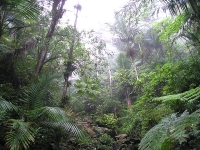
Caribbean National Forest (El Yunque)
The Caribbean National Forest, 35 miles (56km) east of San Juan, is the only tropical rainforest in the United States National Park system and was named El Yunque by the Spanish. Its 28,000 acres contain about 240 different species of tree and numerous other plants, from tiny, delicate wild orchids to gigantic ferns. Visitors can start their visit at the El Portal Tropical Forest Centre where there are films, exhibits and interactive displays. Maps are available of the dozens of walking trails through the forest, graded according to difficulty. Nearby is Puerto Rico's best beach, Luquillo Beach, famous for its soft white sand and towering coconut palms.
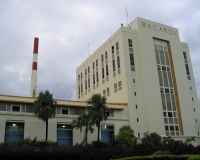
Casa Bacardi Visitor Centre
Undoubtedly one of the top tourist attractions in Puerto Rico, a trip to the Casa Bacardi Visitor Centre is a must for travellers to San Juan. Following exile from Cuba in the 1950s, the Bacardi founders moved to Puerto Rico and set up a small rum distillery on the outskirts of San Juan. It now produces a jaw-dropping 100,000 gallons of rum per day and 21 million cases per year. Tours of the Casa Bacardi Visitor Centre last about an hour, as tour guides show visitors around a variety of exhibits and vintage rum stills, as well as explain the company's history. It culminates in a visit to an on-site, classically-styled bar, where a bartender will show you the proper methods of preparing Cuba libres and mojitos.
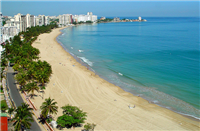
Isla Verde
Isla Verde is San Juan's trendiest area and home to many of its best beach resorts and upmarket hotels. The area's name is inspired by the colour of the water in its bay: a rich green, turquoise hue that proves irresistible to swimmers and divers. The beautiful beach boasts soft sand and the shade of tall palm trees, while visitors can also enjoy world-class spa treatments and a vibrant nightlife. Isla Verde is home to two of the island's best casino hotels and a wide range of raucous clubs and bars with live music. A natural base for well-heeled travellers to San Juan, Isla Verde makes for a luxurious home away from home during your holiday in Puerto Rico.
Getting Around
San Juan's downtown area is old with charming cobble-stoned roads, great for those wanting to explore on foot. So just remember to take comfortable walking shoes, or even hire a bicycle. In fact, many attractions have no convenient parking spots, making driving downtown frustrating.
The Metropolitan Bus Authority (AMA) service covers most of San Juan. Several routes, including those between the old town and the tourist districts, may be useful to visitors. To go farther afield, visitors can flag down one of the plentiful taxis or minibus taxis (publicos).
There is a flat-rate system for most destinations in the city, which often makes getting around by taxi quite economical but most travellers who want to explore the rest of Puerto Rico opt to hire a car, with international car rental agencies well represented.
San Juan Climate and Weather
San Juan, like all of Puerto Rico, has a tropical monsoon climate and enjoys warm, sunny days for most of the year. The tropical climate ensures an average temperature around 81°F (27°C), with an average low of only 71°F (22°C) year-round. Humidity runs continuously at around 80 percent. The rainy season peaks in August, and rain can be extremely heavy with each month receiving rain roughly half of its days. The driest months are February to April. Between August and November the island is vulnerable to hurricanes.
Puerto Rico travel info
Electricity
Electrical current is 120 volts, 60Hz. Two-pin flat attachment plugs are in use.
Language
Spanish and English are the official languages of Puerto Rico.
Money
The United States Dollar (USD) is the unit of currency, which is divided into 100 cents. It is often referred to as the 'peso' in Puerto Rico. ATMs and bureaux de change are freely available and all major credit cards and travellers cheques are generally accepted. Banking hours are 9am to 3.30pm.
Tipping
Some restaurants and hotels automatically add a 10-17 percent service charge to the bill. If not, a 15 percent tip is expected. Taxi drivers and bar staff also expect tips.
Health
There are no vaccination certificates required for travel to Puerto Rico. Cases of dengue fever occur annually and mosquito protection measures are essential, while it's best to drink bottled water to avoid stomach upsets. Medical services are good but can be expensive so travel insurance is advised.
Safety
Puerto Rico is still recovering from Hurricane Maria with regular power and communication outages and unstable buildings.
Visits to Puerto Rico are usually trouble-free but travellers should take sensible precautions to avoid petty theft.
Many travel and health authorities classify Puerto Rico as having a high risk of Zika virus transmission. Visitors are advised to seek advice from health professionals before travel.
Local customs
Social etiquette in Puerto Rico is typically Latin American, with some North American influences such as a stronger sense of female independence, and a toning-down of the machismo ideal. Western visitors to the country should feel comfortable in most social situations.
Hygiene, cleanliness, and personal appearance are viewed as matters of self-respect, so travellers who've been on the road for a little while might consider neatening up their beards or trimming their hair, especially if they want to make a good first impression.
A final, important aspect of Puerto Rican social life, is the concept of relajo. Generally shy of direct confrontation and open criticism, relajo refers to the gentle, joking manner in which Puerto Ricans will bring up uncomfortable issues around each another. Visitors should be aware of this technique, as they may, on occasion, be required to read between the lines to discover what locals are really trying to express.
Doing business
Puerto Rico is a U.S. territory although the resemblance is closer to Latin America. English is understood by many on the island, but Spanish may also be the language in which business is conducted. Dress codes will vary according to different sectors, but suits are favoured on very formal occasions. Shaking hands is common for both men and women. Business hours are generally 9am to 5pm, Monday to Friday, with an hour taken at lunch.
Duty free
Puerto Rico's customs regulations are the same as those for the United States. Visitors over 21 may bring in the following items without paying duty: 200 cigarettes or 100 cigars or 2kg of tobacco; 1 litre of alcohol; and gifts valued up to US$100.
There is a long list of restricted and prohibited items which may not be imported or imported only under license, ranging from fireworks and matches to pre-Columbian sculpture and Cuban cigars. If in doubt, consult your nearest US Embassy for advice. Any merchandise from embargoed countries (Afghanistan, Cuba, Iran, Iraq, Libya, Serbia and Montenegro and the Sudan) may not be brought onto US soil.
Communications
The international access code for Puerto Rico is +1 787 and +1 939. The outgoing code is 011 followed by the relevant country code (e.g. 01144 for the United Kingdom). The outgoing code is not needed for calling the US, Canada, and most of the Caribbean. Mobile phones work throughout the island and local operators use CDMA networks that are not compatible with GSM phones, as used outside North America. Internet cafes are available in most towns and resorts.
Passport & Visa
All passport holders must have an onward or return ticket and documents necessary for further travel. Entry requirements for Puerto Rico are the same as for the United States of America. When arriving from mainland USA there is no immigration control. It is highly recommended that passports have at least six months validity remaining after your intended date of departure from your travel destination. Immigration officials often apply different rules to those stated by travel agents and official sources.
Entry requirements
Valid passport or passport replacing documents are required. Visa not required.
British citizens require a passport valid for period of intended stay. A visa is not required for stays of up to 90 days.
Canadian citizens require a passport valid for period of intended stay. No visa is required.
Australian citizens require a passport valid for period of intended stay. A visa is not required for stays of up to 90 days.
South Africans must hold a passport valid for period of intended stay and a visa is also required, unless holding a valid US visa.
Irish citizens require a passport valid for the period of intended stay. No visa is required for stays of up to 90 days.
New Zealand nationals require a passport valid for the period of intended stay. A visa is not required for touristic stays up to 90 days.
Useful contacts
The Puerto Rican Tourist Company, Old San Juan: +1 787 721 2400 or www.gotopuertorico.com
Emergencies: 911Embassies / consulates in other countries
United States Embassy, London, United Kingdom: +44 (0)20 7499 9000.
United States Embassy, Ottawa, Canada: +1 613 238 5335.
United States Embassy, Canberra, Australia: +61 (0)2 6214 5600.
United States Embassy, Pretoria, South Africa: +27 (0)12 431 4000.
United States Embassy, Dublin, Ireland: +353 (0)1 668 8777.
United States Embassy, Wellington, New Zealand: +64 (0)4 462 6000.
Embassies / consulates in Puerto Rico
British Consulate, San Juan: +1 787 850 2400.
Canadian Embassy, Washington DC, United States (also responsible for Puerto Rico): +1 (202) 682 1740.
Australian Embassy, Washington DC, United States (also responsible for Puerto Rico): +1 202 797 3000.
South African Embassy, Washington DC, United States (also responsible for Puerto Rico): +1 202 232 4400.
Irish Embassy, Washington DC, United States (also responsible for Puerto Rico): +1 202 462 3939.
New Zealand Embassy, Washington DC, United States (also responsible for Puerto Rico): +1 202 328 4800.



